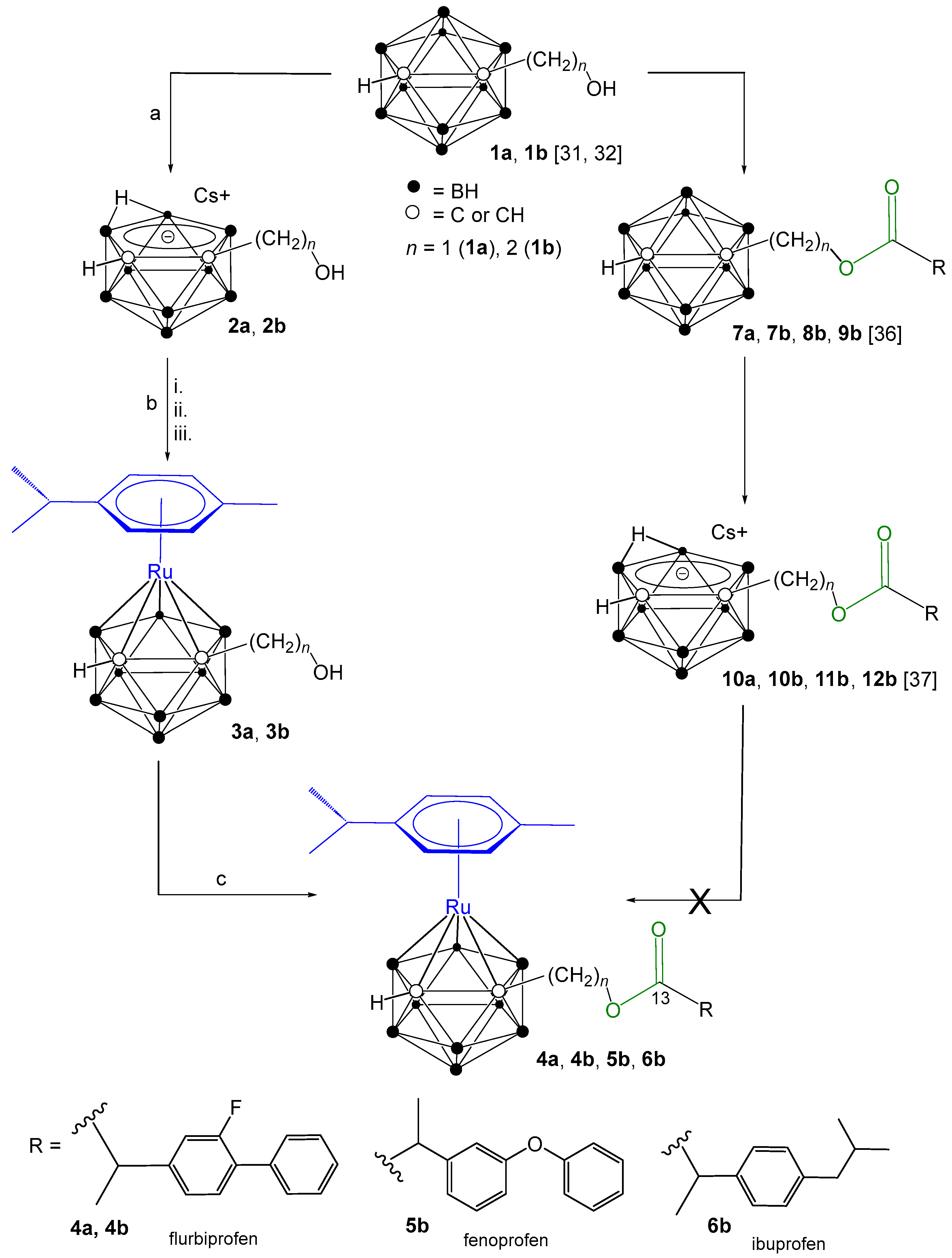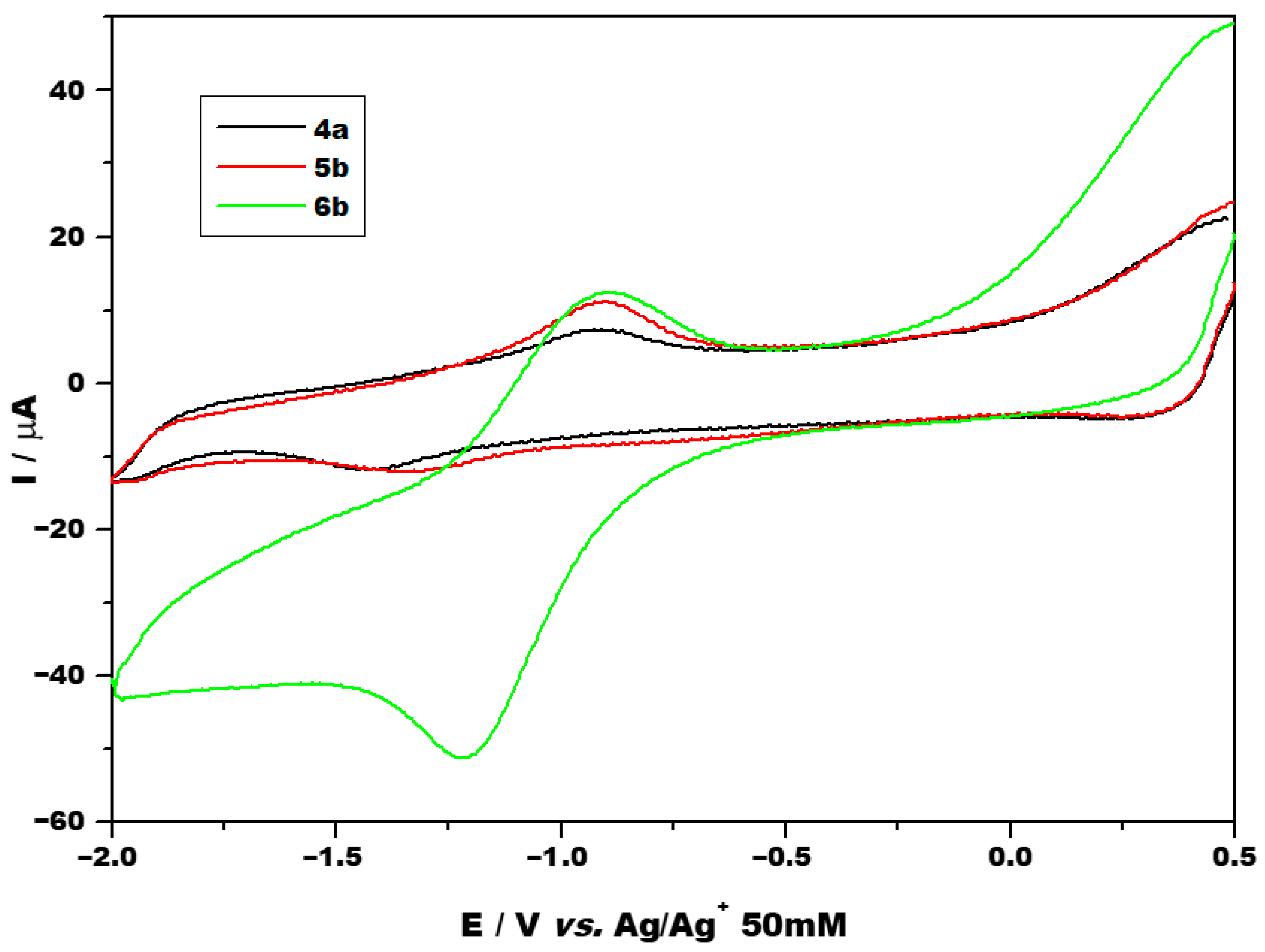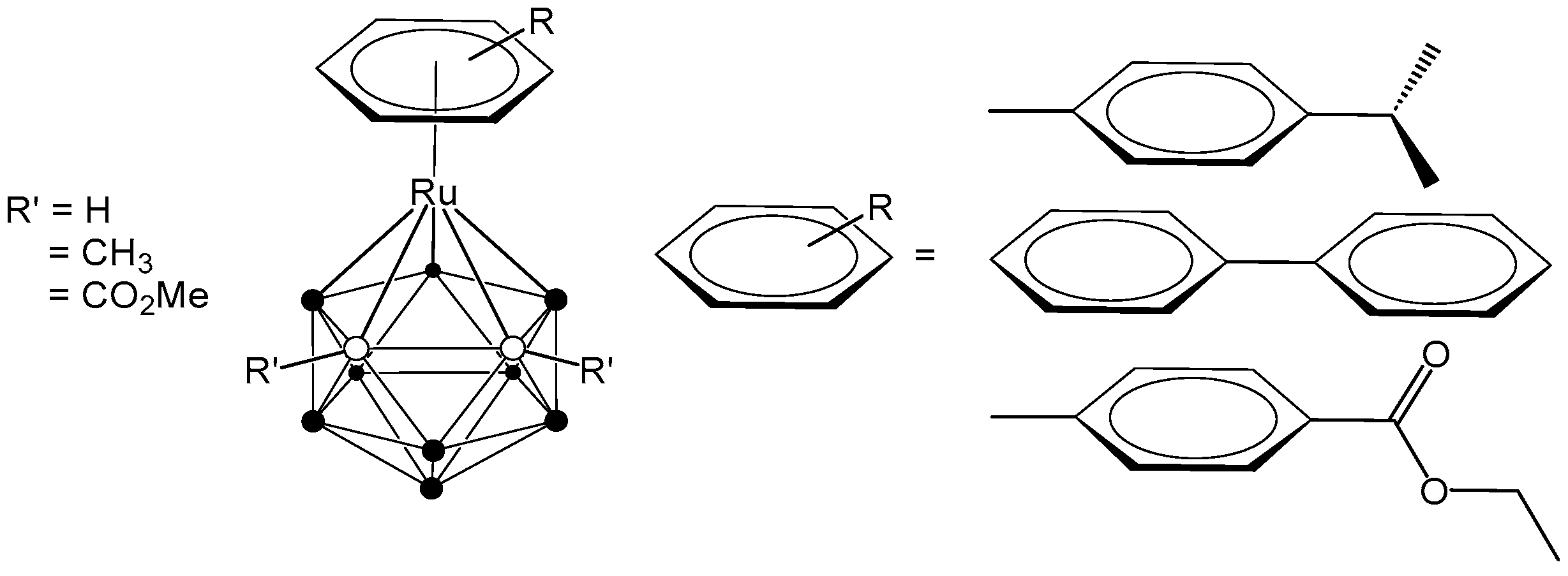Novel Ruthenacarborane–NSAID Conjugates
Abstract
1. Introduction
2. Results and Discussion
2.1. Synthesis and Characterization of Ruthenacarborane-(η6-p-cymene)–NSAID Conjugates
2.2. Cyclic Voltammetry
2.3. Stability Studies
2.4. COX Inhibitory Potential
2.5. Cytotoxicity, Toxicity and Mechanism of Action
3. Materials and Methods
3.1. General Synthesis of Nido-Carborane Precursors (2a and 2b)
3.2. General Synthesis of Ruthenacarborane ([Ru(η6-p-cymene)-closo-1-(CH2)nOH-C2B9H10], (n = 1, 2))
3.2.1. Deprotonation of the Nido-Carborane Precursors
3.2.2. Formation of Ruthenacarborane (3a and 3b)
3.3. General Synthesis of Ruthenacarborane-(η6-p-cymene)–NSAID Conjugates ([Ru(η6-p-cymene)-closo-C2B9H10-(CH2)n-NSAID] (n = 1, 2)) (4a, 4b, 5b, and 6b)
3.4. Purity Analysis by High Performance Liquid Chromatography (HPLC)
3.5. Evaluation for COX Inhibition
3.6. Cyclic Voltammetry Methodology
3.7. Stability Studies Methodology
3.8. In Vitro Assays
3.8.1. Reagents
3.8.2. Cell Lines
3.8.3. Viability Assays: MTT and Crystal Violet (CV)
3.8.4. Statistical Analysis
4. Conclusions
Supplementary Materials
Author Contributions
Funding
Data Availability Statement
Conflicts of Interest
Abbreviations
| NSAIDs | Non-Steroidal Anti-Inflammatory Drugs |
| COX | Cyclooxygenase |
| NMR | Nuclear Magnetic Resonance |
| CV | Crystal Violet |
| CV | Cyclic Voltammetry |
| MTT | 3-(4,5-Dimethylthiazol-2-yl)-2,5-diphenyltetrazolium bromide |
| HPLC | High-Performance Liquid Chromatography |
| HATU | O-(7-Azabenzotriazol-1-yl)-N,N,N′,N′-tetramethyluronium hexafluorophosphate |
| DIPEA | N,N-Diisopropylethylamine |
| DLS | Dynamic Light Scattering |
| PBS | Phosphate-Buffered Saline |
| PFA | Paraformaldehyde |
| TMS | Tetramethylsilane |
| BNCT | Boron Neutron Capture Therapy |
| TLC | Thin-Layer Chromatography |
References
- Bray, F.; Laversanne, M.; Weiderpass, E.; Soerjomataram, I. The ever-increasing importance of cancer as a leading cause of premature death worldwide. Cancer 2021, 127, 3029–3030. [Google Scholar] [CrossRef] [PubMed]
- Galanski, M.S.; Jakupec, M.A.; Keppler, B.K. Update of the Preclinical Situation of Anticancer Platinum Complexes: Novel Design Strategies and Innovative Analytical Approaches. Curr. Med. Chem. 2005, 12, 2075–2094. [Google Scholar] [CrossRef] [PubMed]
- Galanski, M.S. Recent Developments in the Field of Anticancer Platinum Complexes. Recent Pat. Anticancer Drug Discov. 2006, 1, 285–295. [Google Scholar] [CrossRef]
- Brabec, V.; Kasparkova, J. Modifications of DNA by platinum complexes. Relation to resistance of tumors to platinum antitumor drugs. Drug Resist. Updat. 2005, 8, 131–146. [Google Scholar] [CrossRef]
- Ott, I.; Gust, R. Non platinum metal complexes as anti-cancer drugs. Arch. Pharm. 2007, 340, 117–126. [Google Scholar] [CrossRef]
- Zhang, P.; Sadler, P.J. Advances in the design of organometallic anticancer complexes. J. Organomet. Chem. 2017, 839, 5–14. [Google Scholar] [CrossRef]
- Sava, G.; Bergamo, A. Ruthenium Drugs for Cancer Chemotherapy: An Ongoing Challenge to Treat Solid Tumours. In Platinum and Other Heavy Metal in Cancer Chemotherapy: Molecular Mechanisms and Clinical Applications; Bonetti, A., Leone, R., Muggia, F., Howell, S.B., Eds.; Humana Press: Totowa, NJ, USA, 2009; pp. 57–66. [Google Scholar]
- Kostova, I. Ruthenium complexes as anticancer agents. Curr. Med. Chem. 2006, 13, 1085–1107. [Google Scholar] [CrossRef]
- Heffeter, P.; Jungwirth, U.; Jakupec, M.; Hartinger, C.; Galanski, M.S.; Elbling, L.; Micksche, M.; Keppler, B.; Berger, W. Resistance against novel anticancer metal compounds: Differences and similarities. Drug Resist. Updat. 2008, 11, 1–16. [Google Scholar] [CrossRef]
- Sava, G.; Zorzet, S.; Giraldi, T.; Mestroni, G.; Zassinovich, G. Antineoplastic activity and toxicity of an organometallic complex of ruthenium(II) in comparison with cis-PDD in mice bearing solid malignant neoplasms. Eur. J. Cancer Clin. Oncol. 1984, 20, 841–847. [Google Scholar] [CrossRef]
- Sava, G.; Bergamo, A. Ruthenium-based compounds and tumour growth control (review). Int. J. Oncol. 2000, 17, 353–365. [Google Scholar] [CrossRef] [PubMed]
- Schluga, P.; Hartinger, C.G.; Egger, A.; Reisner, E.; Galanski, M.S.; Jakupec, M.A.; Keppler, B.K. Redox behavior of tumor-inhibiting ruthenium(III) complexes and effects of physiological reductants on their binding to GMP. Dalton Trans. 2006, 14, 1796–1802. [Google Scholar] [CrossRef]
- Rockwell, S.; Dobrucki, I.T.; Kim, E.Y.; Marrison, S.T.; van Vu, T. Hypoxia and radiation therapy: Past history, ongoing research, and future promise. Curr. Mol. Med. 2009, 9, 442–458. [Google Scholar] [CrossRef]
- Gagliardi, R.; Sava, G.; Pacor, S.; Mestroni, G.; Alessio, E. Antimetastatic action and toxicity on healthy tissues of Na[trans-RuCl4(DMSO)Im] in the mouse. Clin. Exp. Metastasis 1994, 12, 93–100. [Google Scholar] [CrossRef] [PubMed]
- Bergamo, A.; Sava, G. Modulation of the metastatic progression of breast cancer with an organometallic ruthenium compound. Int. J. Oncol. 1992, 1, 641–648. [Google Scholar] [CrossRef]
- Sava, G.; Pacor, S.; Mestroni, G.; Alessio, E. Na[trans-RuCl4(DMSO)Im], a metal complex of ruthenium with antimetastatic properties. Clin. Exp. Metastasis 1992, 10, 273–280. [Google Scholar] [CrossRef]
- Sava, G.; Pacor, S.; Bergamo, A.; Cocchietto, M.; Mestroni, G.; Alessio, E. Effects of ruthenium complexes on experimental tumors: Irrelevance of cytotoxicity for metastasis inhibition. Chem. Biol. Interact. 1995, 95, 109–126. [Google Scholar] [CrossRef] [PubMed]
- Jakupec, M.A.; Arion, V.B.; Kapitza, S.; Reisner, E.; Eichinger, A.; Pongratz, M.; Marian, B.; Graf von Keyserlingk, N.; Keppler, B.K. KP1019 (FFC14A) from bench to bedside: Preclinical and early clinical development—An overview. Int. J. Clin. Pharmacol. Ther. 2005, 43, 595–596. [Google Scholar] [CrossRef] [PubMed]
- Hartinger, C.G.; Jakupec, M.A.; Zorbas-Seifried, S.; Groessl, M.; Egger, A.; Berger, W.; Zorbas, H.; Dyson, P.J.; Keppler, B.K. KP1019, a new redox-active anticancer agent-preclinical development and results of a clinical phase I study in tumor patients. Chem. Biodivers. 2008, 5, 2140–2155. [Google Scholar] [CrossRef] [PubMed]
- Grimes, R.N. (Ed.) Carboranes, 3rd ed.; Academic Press: Cambridge, MA, USA, 2016. [Google Scholar]
- Varaksin, M.V.; Smyshliaeva, L.A.; Rusinov, V.L.; Makeev, O.G.; Melekhin, V.V.; Baldanshirieva, A.D.; Gubina, O.G.; Charushin, V.N.; Chupakhin, O.N. Synthesis, characterization, and in vitro assessment of cytotoxicity for novel azaheterocyclic nido-carboranes—Candidates in agents for boron neutron capture therapy (BNCT) of cancer. Tetrahedron 2021, 102, 132525. [Google Scholar] [CrossRef]
- Marforio, T.D.; Carboni, A.; Calvaresi, M. In Vivo Application of Carboranes for Boron Neutron Capture Therapy (BNCT): Structure, Formulation and Analytical Methods for Detection. Cancers 2023, 15, 4944. [Google Scholar] [CrossRef]
- Issa, F.; Kassiou, M.; Rendina, L.M. Boron in drug discovery: Carboranes as unique pharmacophores in biologically active compounds. Chem. Rev. 2011, 111, 5701–5722. [Google Scholar] [CrossRef] [PubMed]
- Gozzi, M.; Murganic, B.; Drača, D.; Popp, J.; Coburger, P.; Maksimović-Ivanić, D.; Mijatović, S.; Hey-Hawkins, E. Quinoline-Conjugated Ruthenacarboranes: Toward Hybrid Drugs with a Dual Mode of Action. ChemMedChem 2019, 14, 2061–2074. [Google Scholar] [CrossRef] [PubMed]
- Gozzi, M.; Schwarze, B.; Sárosi, M.-B.; Lönnecke, P.; Drača, D.; Maksimović-Ivanić, D.; Mijatović, S.; Hey-Hawkins, E. Antiproliferative activity of (η6-arene)ruthenacarborane sandwich complexes against HCT116 and MCF7 cell lines. Dalton Trans. 2017, 46, 12067–12080. [Google Scholar] [CrossRef] [PubMed]
- Gozzi, M.; Schwarze, B.; Coburger, P.; Hey-Hawkins, E. On the Aqueous Solution Behavior of C-Substituted 3,1,2-Ruthenadicarbadodecaboranes. Inorganics 2019, 7, 91. [Google Scholar] [CrossRef]
- Drača, D.; Marković, M.; Gozzi, M.; Mijatović, S.; Maksimović-Ivanić, D.; Hey-Hawkins, E. Ruthenacarborane and Quinoline: A Promising Combination for the Treatment of Brain Tumors. Molecules 2021, 26, 3801. [Google Scholar] [CrossRef]
- Pelletier, J.-P.; Martel-Pelletier, J.; Rannou, F.; Cooper, C. Efficacy and safety of oral NSAIDs and analgesics in the management of osteoarthritis: Evidence from real-life setting trials and surveys. Semin. Arthritis Rheum. 2016, 45, S22–S27. [Google Scholar] [CrossRef]
- Crofford, L.J. Use of NSAIDs in treating patients with arthritis. Arthritis Res. Ther. 2013, 15, S2. [Google Scholar] [CrossRef]
- Hobson, A. The Medicinal Chemistry of Glucocorticoid Receptor Modulators; Springer Nature: Cham, Switzerland, 2023; ISBN 978-3-031-28731-2. [Google Scholar]
- Hoogendoorn, S.; Mock, E.D.; Strijland, A.; Donker-Koopman, W.E.; van den Elst, H.; van den Berg, R.J.B.H.N.; Aerts, J.M.F.G.; van der Marel, G.A.; Overkleeft, H.S. ortho-Carborane-Modified N-Substituted Deoxynojirimycins. Eur. J. Org. Chem. 2015, 2015, 4437–4446. [Google Scholar] [CrossRef]
- Ahrens, V.M.; Frank, R.; Stadlbauer, S.; Beck-Sickinger, A.G.; Hey-Hawkins, E. Incorporation of ortho-carbaboranyl-Nε-modified L-lysine into neuropeptide Y receptor Y1- and Y2-selective analogues. J. Med. Chem. 2011, 54, 2368–2377. [Google Scholar] [CrossRef]
- Huskisson, E.C.; Wojtulewski, J.A.; Berry, H.; Scott, J.; Hart, F.D.; Balme, H.W. Treatment of rheumatoid arthritis with fenoprofen: Comparison with aspirin. Br. Med. J. 1974, 1, 176–180. [Google Scholar] [CrossRef]
- Traa, M.X.; Derry, S.; Moore, R.A. Single dose oral fenoprofen for acute postoperative pain in adults. Cochrane Database Syst. Rev. 2011, 2011, CD007556. [Google Scholar] [CrossRef]
- Edelson, A.M. John Robert Vane: 1927–2004. J. Cardiovasc. Pharmacol. 2005, 45, 280–282. [Google Scholar] [CrossRef] [PubMed]
- Sonam, S.; Jelača, S.; Laube, M.; Schädlich, J.; Pietzsch, J.; Maksimović-Ivanić, D.; Mijatović, S.; Kaluđerović, G.N.; Hey-Hawkins, E. Carborane Conjugates with Ibuprofen, Fenoprofen and Flurbiprofen: Synthesis, Characterization, COX Inhibition Potential and In Vitro Activity. ChemMedChem 2025, 20, e202400018. [Google Scholar] [CrossRef]
- Sonam, S.; Mojić, M.; Laube, M.; Schädlich, J.; Pietzsch, J.; Mijatović, S.; Maksimović-Ivanić, D.; Hey-Hawkins, E.; Kaluđerović, G.N. nido-Carborane Conjugates with Ibuprofen, Flurbiprofen and Fenoprofen: Synthesis, Characterization, COX Inhibition Potential and Anticancer Activity. RSC Med. Chem. 2025, Submitted. [Google Scholar]
- Rosso, C.; Birolo, R.; Gallo, A.; Franks, W.T.; Priola, E.; Chierotti, M.R.; Gobetto, R. Exploring Tyramine’s Role in the Formation of Supramolecular Adducts with Nonsteroidal Anti-Inflammatory Drugs. Chem. Eur. J. 2025, 31, e202500080. [Google Scholar] [CrossRef] [PubMed]
- Conradie, J. Redox behaviour of [Ru(β-diketonato)3] compounds. Electrochim. Acta 2020, 337, 135801. [Google Scholar] [CrossRef]
- Escolà, A.; Crespo, M.; López, C.; Quirante, J.; Jayaraman, A.; Polat, I.H.; Badía, J.; Baldomà, L.; Cascante, M. On the stability and biological behavior of cyclometallated Pt(IV) complexes with halido and aryl ligands in the axial positions. Bioorg. Med. Chem. 2016, 24, 5804–5815. [Google Scholar] [CrossRef]
- Worsley, C.M.; Veale, R.B.; Mayne, E.S. The acidic tumour microenvironment: Manipulating the immune response to elicit escape. Hum. Immunol. 2022, 83, 399–408. [Google Scholar] [CrossRef]
- Toft, N.J.; Axelsen, T.V.; Pedersen, H.L.; Mele, M.; Burton, M.; Balling, E.; Johansen, T.; Thomassen, M.; Christiansen, P.M.; Boedtkjer, E. Acid-base transporters and pH dynamics in human breast carcinomas predict proliferative activity, metastasis, and survival. Elife 2021, 10, e68447. [Google Scholar] [CrossRef]
- He, Q.; Chen, J.; Yan, J.; Cai, S.; Xiong, H.; Liu, Y.; Peng, D.; Mo, M.; Liu, Z. Tumor microenvironment responsive drug delivery systems. Asian J. Pharm. Sci. 2019, 15, 416–448. [Google Scholar] [CrossRef]
- Yang, X.; Pan, Z.; Choudhury, M.R.; Yuan, Z.; Anifowose, A.; Yu, B.; Wang, W.; Wang, B. Making smart drugs smarter: The importance of linker chemistry in targeted drug delivery. Med. Res. Rev. 2020, 40, 2682–2713. [Google Scholar] [CrossRef]
- Valliant, J.F.; Guenther, K.J.; King, A.S.; Morel, P.; Schaffer, P.; Sogbein, O.O.; Stephenson, K.A. The medicinal chemistry of carboranes. Coord. Chem. Rev. 2002, 232, 173–230. [Google Scholar] [CrossRef]
- Watson, D.J.; Harper, S.E.; Zhao, P.L.; Quan, H.; Bolognese, J.A.; Simon, T.J. Gastrointestinal tolerability of the selective cyclooxygenase-2 (COX-2) inhibitor rofecoxib compared with nonselective COX-1 and COX-2 inhibitors in osteoarthritis. Arch. Intern. Med. 2000, 160, 2998–3003. [Google Scholar] [CrossRef] [PubMed]
- Whittle, B.J. COX-1 and COX-2 products in the gut: Therapeutic impact of COX-2 inhibitors. Gut 2000, 47, 320–325. [Google Scholar] [CrossRef]
- Perrin, D.D.; Armarego, W.L.F.; Perrin, D.R. Purification of Laboratory Chemicals, 2nd ed.; Pergamon Press: Oxford, UK, 1987; ISBN 9780080229614. [Google Scholar]
- Harris, R.K.; Becker, E.D.; Cabral de Menezes, S.M.; Goodfellow, R.; Granger, P. NMR nomenclature: Nuclear spin properties and conventions for chemical shifts. IUPAC Recommendations 2001. International Union of Pure and Applied Chemistry. Physical Chemistry Division. Commission on Molecular Structure and Spectroscopy. Magn. Reson. Chem. 2002, 40, 489–505. [Google Scholar] [CrossRef]
- Useini, L.; Mojić, M.; Laube, M.; Lönnecke, P.; Mijatović, S.; Maksimović-Ivanić, D.; Pietzsch, J.; Hey-Hawkins, E. Carborane Analogues of Fenoprofen Exhibit Improved Antitumor Activity. ChemMedChem 2023, 18, e202200583. [Google Scholar] [CrossRef]


| 4a | 5b | 6b | ||
|---|---|---|---|---|
| Ru center | Epc [V vs. Ag/Ag+] | −1.42 | −1.316 | −1.216 |
| Epa [V vs. Ag/Ag+] | −0.941 | −0.918 | −0.93 | |
| E1/2 [V vs. Ag/Ag+] | −1.18 | −1.12 | −1.07 | |
| ΔEp [V] | 0.479 | 0.398 | 0.286 | |
| k° [cm/s] | 8.4×10−6 | 1.2×10−5 | 5.2×10−5 | |
| Ligand | Epc [V vs. Ag/Ag+] | −2.43 | −2.21 | - |
| Epa [V vs. Ag/Ag+] | −1.91 | - | - |
| % Inhibition @ 100 µM | IC50 [µM] | SI *** | |||
|---|---|---|---|---|---|
| COX-1 | COX-2 | COX-1 | COX-2 | ||
| 1a | n.i. * | n.i. | - ** | - | - |
| 1b | n.i. | n.i. | - | - | - |
| 2a | 6 | 38 | - | - | - |
| 2b | 23 | 56 | - | 84.1 | >1.2 |
| 3a | 18 | 14 | - | - | - |
| 3b | 21 | 25 | - | - | - |
| 4a | 33 | 18 | - | - | - |
| 4b | 40 | 21 | - | - | - |
| 5b | n.i. | n.i. | - | - | - |
| 6b | 30 | 11 | - | - | - |
| 7a [36] | 63 | 37 | 30.6 | >100 | <0.3 |
| 7b [36] | n.i. | 23 | - | - | - |
| 8b [36] | n.i. | 11 | - | - | - |
| 9b [36] | 15 | n.i. | - | - | - |
| 10a [37] | 105 | 104 | 1.645 | 7.845 | 0.21 |
| 10b [37] | 106 | 104 | 3.132 | 4.509 | 0.69 |
| 11b [37] | 104 | 105 | 7.173 | 4.004 | 1.8 |
| 12b [37] | 104 | 103 | 10.75 | 2.879 | 3.7 |
| Ibuprofen | n.i. | 27 | - | - | - |
| Flurbiprofen | 82 | 97 | 0.85 | 0.07 | 11.2 |
| Fenoprofen | 5 | 26 | - | - | - |
| Celecoxib | - | - | - | 0.138 | - |
| SC-560 | - | - | 0.013 | - | - |
| A375 | A549 | HCT116 | HT29 | MDA-MB-231 | MRC5 | |||||||
|---|---|---|---|---|---|---|---|---|---|---|---|---|
| MTT | CV | MTT | CV | MTT | CV | MTT | CV | MTT | CV | MTT | CV | |
| 2a | >200 | >200 | >200 | 191.7 ± 11.8 | >200 | >200 | >200 | >200 | >200 | >200 | >200 | >200 |
| 2b | >200 | >200 | >200 | 176.1 ± 1.1 | >200 | >200 | >200 | >200 | >200 | 187.7 ± 5.9 | >200 | >200 |
| 3a | 20.5 ± 1.8 | 25.1 ± 2.6 | 20.6 ± 1.3 | 21.4 ± 1.1 | 22.8 ± 1.6 | 23.4 ± 0.7 | 33.4 ± 2.8 | 25.8 ± 2.2 | 31.6 ± 1.9 | 26.8 ± 1.6 | 35.4 ± 1.2 | 34.9 ± 2.1 |
| 3b | 20.9 ± 2.0 | 29.0 ± 2.2 | 19.7 ± 0.1 | 19.5 ± 1.8 | 19.9 ± 0.4 | 21.8 ± 1.2 | 36.3 ± 0.8 | 33.4 ± 0.8 | 23.3 ± 0.8 | 18.6 ± 1.3 | 35.0 ± 1.8 | 30.0 ± 2.9 |
| 4a | >200 | >200 | >200 | >200 | >200 | >200 | >200 | >200 | >200 | >200 | >200 | >200 |
| 4b | >200 | >200 | >200 | >200 | >200 | >200 | >200 | >200 | >200 | >200 | >200 | >200 |
| 5b | >200 | >200 | >200 | >200 | >200 | >200 | >200 | >200 | >200 | >200 | >200 | >200 |
| 6b | >200 | >200 | >200 | >200 | >200 | >200 | >200 | >200 | >200 | >200 | >200 | >200 |
Disclaimer/Publisher’s Note: The statements, opinions and data contained in all publications are solely those of the individual author(s) and contributor(s) and not of MDPI and/or the editor(s). MDPI and/or the editor(s) disclaim responsibility for any injury to people or property resulting from any ideas, methods, instructions or products referred to in the content. |
© 2025 by the authors. Licensee MDPI, Basel, Switzerland. This article is an open access article distributed under the terms and conditions of the Creative Commons Attribution (CC BY) license (https://creativecommons.org/licenses/by/4.0/).
Share and Cite
Sonam, S.; Mojić, M.; Gordić, V.; Laube, M.; Schädlich, J.; Pietzsch, J.; Nicoara, A.; Gaina, L.; Mijatović, S.; Maksimović-Ivanić, D.; et al. Novel Ruthenacarborane–NSAID Conjugates. Molecules 2025, 30, 4153. https://doi.org/10.3390/molecules30214153
Sonam S, Mojić M, Gordić V, Laube M, Schädlich J, Pietzsch J, Nicoara A, Gaina L, Mijatović S, Maksimović-Ivanić D, et al. Novel Ruthenacarborane–NSAID Conjugates. Molecules. 2025; 30(21):4153. https://doi.org/10.3390/molecules30214153
Chicago/Turabian StyleSonam, Sonam, Marija Mojić, Vuk Gordić, Markus Laube, Jonas Schädlich, Jens Pietzsch, Adrian Nicoara, Luiza Gaina, Sanja Mijatović, Danijela Maksimović-Ivanić, and et al. 2025. "Novel Ruthenacarborane–NSAID Conjugates" Molecules 30, no. 21: 4153. https://doi.org/10.3390/molecules30214153
APA StyleSonam, S., Mojić, M., Gordić, V., Laube, M., Schädlich, J., Pietzsch, J., Nicoara, A., Gaina, L., Mijatović, S., Maksimović-Ivanić, D., Kaluđerović, G. N., & Hey-Hawkins, E. (2025). Novel Ruthenacarborane–NSAID Conjugates. Molecules, 30(21), 4153. https://doi.org/10.3390/molecules30214153








